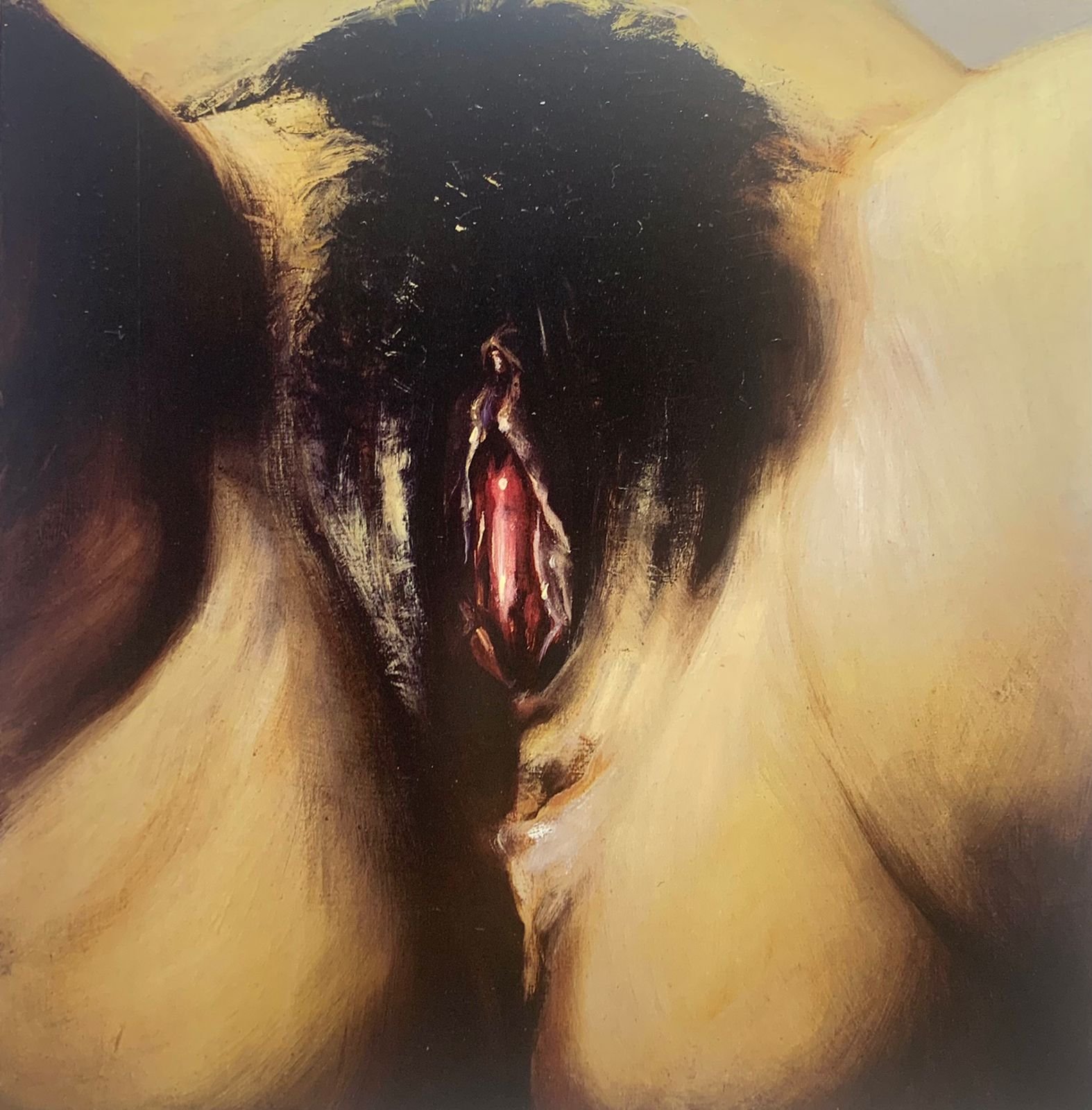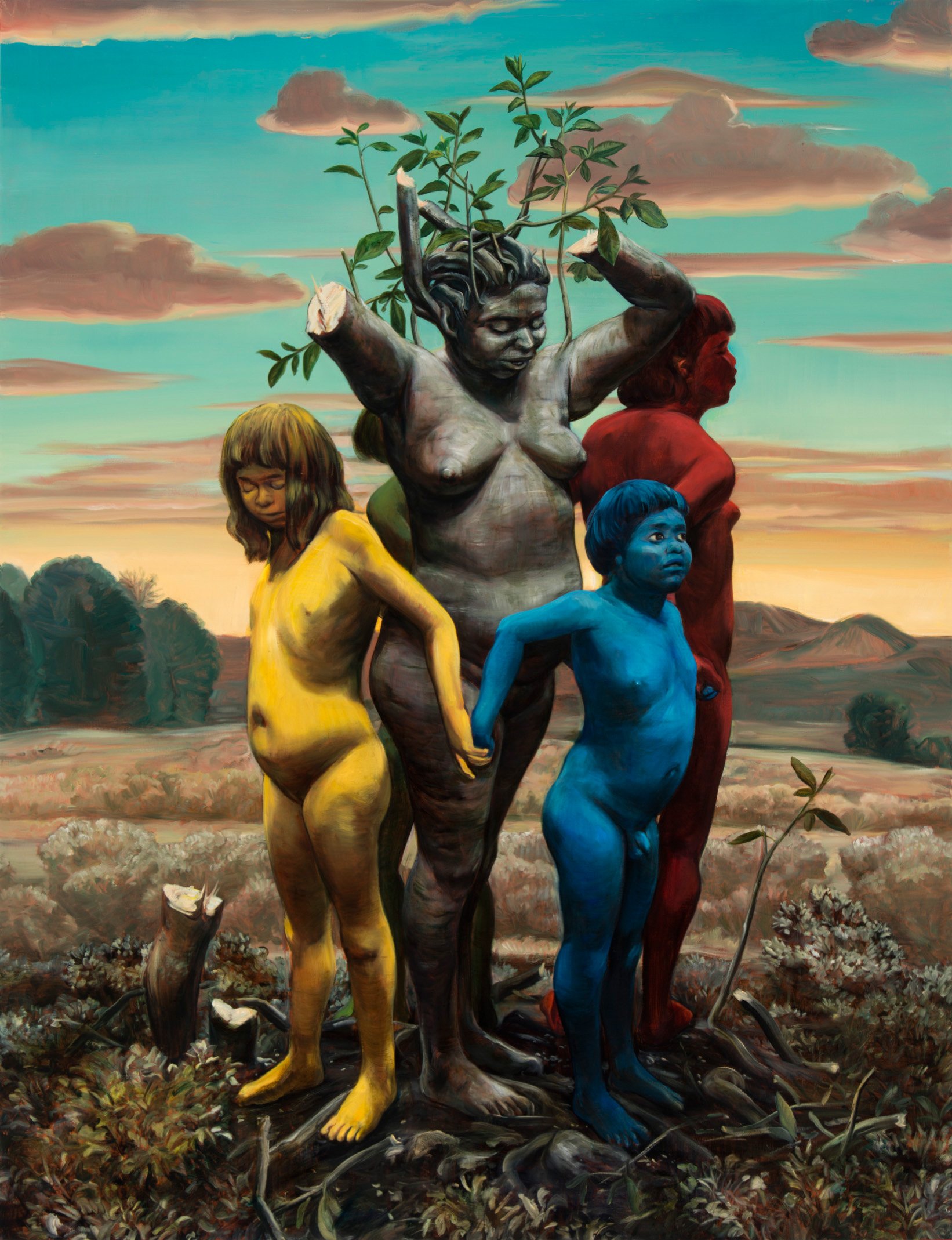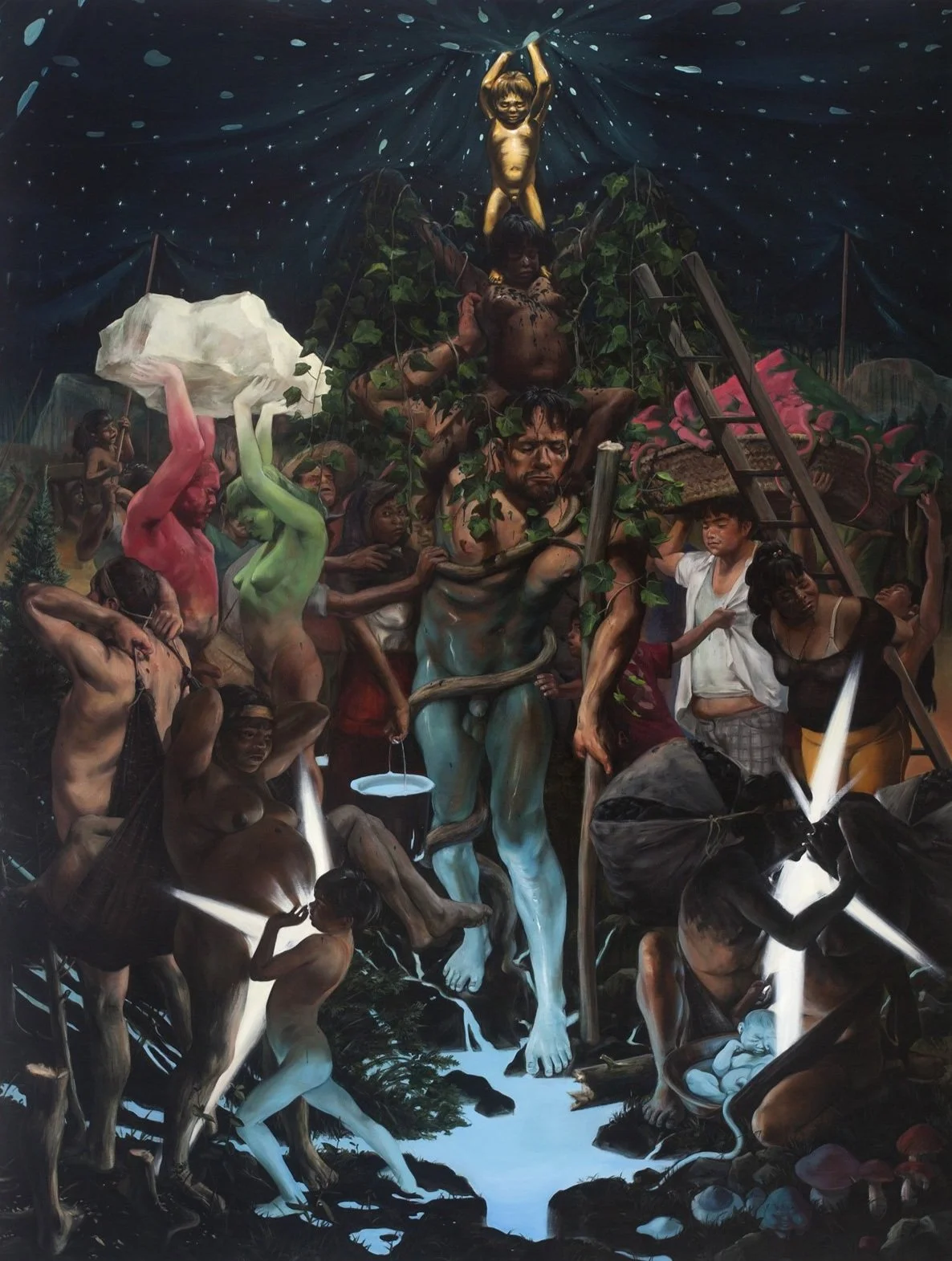
Daniel Lezama
__________________________________________________________________
Daniel Lezama: The Prodigal Family
by Valerie Campos Maldonado (Junio, 2022)
Immobile in the light, yet dancing, your movement to the stillness that breeds at the top of the vertigo allies arrested, not to the flight, but to the instant.
— Octavio Paz
Daniel Lezama, La fogata, óleo sobre tela.
Daniel Lezama, Tonanzin-Guadalupe, óleo sobre tela.
There are many perspectives from which one can look at the work of Daniel Lezama, who, for over two decades, has baffled the viewer with his ability to shape the intangible and paradoxical. But certainly, reflecting on art does not mean searching for a definitive meaning or one that is compatible with the artist's intention, but rather pointing out the existential and psychological vertigo that affirms the author in their own work and, above all, the array of realities defined as allegories of the world that surrounds them.
Daniel Lezama's choice for painting was made definitive in the nineties, when curators persuaded a generation of artists to produce installations, video art and performance in order to survive the art world, so much so that over the years he clung more and more to his craft, reaffirming a stance that confronted the opportunism of his time.
Daniel Lezama looks at Mexico and from Mexico in his approach to painting; the contemplation of his own cultural being as the key to an important aesthetic display. The contrast between the dreamlike and unreal quality imposed by the surrealist perspective and the need for truth as opposed to the narrative of object painting; a form of academicism that he uses to embody a neo-baroque vision that fuses the metaphysical beauty of the indigenous past with the chaos of modernity.
Complex compositions that unfold in large format paintings where the painter is introduced as a character in the pursuit of a symbolic narrative balance, threatened by the evidence of a permanent and vital angst that arises in the reappearance of ancestral traits within a collective organism that defines itself, regardless of time.
Tonanzin-Guadalupe (2003) is a work that represents The Origin of the world long before Courbet, according to the words of Daniel Lezama in his book of the same name published by Hilario Galguera in 2008. This painting shows the figure of the Virgin of Guadalupe on the lips of an open vagina in an honored body, stripped of certainties, pregnant with enigmas, faceless, placed in front of the viewer, away from any doubt, as a sacred symbol of absolute sincerity. Based on this approach, the theory of space/time may seem contradictory for Daniel Lezama, as he is in a constant search for sacrifice and, at the same time, for offering. A work that demands the viewer to strengthen their memory, an open look at restlessness, a sign that we are before a piece that is strictly linked to its contemporaneity and that at the same time shows opposite assessments with regard to the future of painting.
Daniel Lezama, El llano en llamas, Óleo sobre tela.
The Mexican flag with the image of the Virgin of Guadalupe at its center is repeated in several of his works, as in La fogata (2006), in which the body of a child rises above the fire on a witches' night with a full moon. It is evident that Daniel Lezama gathers the popular vision of Goya's covens to reinterpret his own view of the bacchanal in Mexican culture, as in his work El llano en llamas (2005), in reference to Juan Rulfo's book of short stories about the memory and the ravages of the Mexican Revolution. Mestizos, singers, murderers, and drunkards engaged in domestic chores around a bonfire, as in La fiesta de los cerros (2004), with a composition that reminds us of Los fusilamientos del 3 de Mayo (1814), by the same Aragonese painter, which depicts the struggle of the Spanish people against French domination. Perhaps in Daniel's reinterpretation, the intention is to refer to a celebration in which all the people participate regardless of social class, creating an allegory of what political elections represent. The characters are united in baroque compositions that simultaneously echo both Renaissance art and socialist realism, yet the situations remain isolated from one another, seeming to take place in a stubbornly elusive parallel world. While there is conflict in every scene, there is no terror or distress, all the characters seem to be calm no matter what violent situation they are involved in. As Juan Rulfo wrote in his novel Pedro Páramo: It had been so many years since I had raised my face that I forgot the sky. Just as in literature, in painting the most terrible things can be told through a language that is not necessarily melodramatic. Victims and perpetrators share the same scene and depend on each other. There is no painting without tension, as there is no progress without conflict, hence the work of Daniel Lezama visually cites images of various artists of the twentieth century, who like Paula Rego, Balthus, Freud and Fischl dealt with social breakdowns in their respective historical moments.The Prodigal Mother (2008), a 240 x 640 cm. composition, is a strong symbolic representation of a true fact, an allegory of Liberty, as painted by Eugene Delacroix in his painting Liberty Leading the People (1830). Daniel Lezama's painting of The Prodigal Mother also depicts a pyramidal scene under a sky in the style of Tiepolo; a human barricade from which a series of situations unfold that prevent the mother-earth wearing the Mexican flag under her skirt from freeing herself from her bonds and crossing over the fallen.
Daniel Lezama, La madre pródiga, óleo sobre tela.
Daniel Lezama's palette changed radically in 2012 during the process of his Árboles de Tamoanchán series. Already in paintings such as Cargadores (2012), an illuminated channel that endows a child with supernatural powers to release a light that leads to a mother's womb stands out in the composition. White edges of lighting or supernatural calm where a discordant color bursts in. Later on, underexposed or faded stories and canvases of dramatic, almost fluorescent colors. In this way, Daniel Lezama employs his ability to overturn ordinary notions of spatial proportion in painting. This allows him to present disparate, cumulative and simultaneous scenarios, something that can only be achieved through pictorial means. At this stage, the color palette and the serene and impassive facial expressions of some of Daniel Lezama's characters are reminiscent of the German painter Neo Rauch and of Western religious art, especially Giotto, the pre-renaissance Italian master that was active on the edge of a humanist artistic movement that placed man at the center of the universe and made him the master of his own destiny. From all these spheres, Daniel Lezama adopts visions and perspectives that remain with him, and he gradually refines his pictorial vocabulary, partly derived from literature and poetry. Somewhere between movement and stillness, painting as an eternity of the instantaneous that transfigures temporal and spatial perspectives in complex compositions, taking the woman's body as a starting point; pure thesis of evolution on the canvas, landscape, infinite horizon of possibilities and annunciations; poetic unfolding that observes the rhythm and authority that the feminine force demands in the absence of linearity and logic. Its protagonist: woman volcano, woman trunk, woman tree, woman mushroom, woman light, woman fire, woman mother, woman child and in the words of Daniel Lezama: The Prodigal Mother who has given birth to us all, as asserted by her heavy breasts and her ample belly.
Daniel Lezama, Familia (serie Árboles de Tamoanchán), óleo sobre tela.
Daniel Lezama, Los cargadores, óleo sobre tela.
Mid-day Vertigos is the title Daniel Lezama has chosen for his exhibition at the Museum of Modern Art, based on a remark by Octavio Paz in his book The Labyrinth of Solitude. Painting, like poetry, is subject to continuous evolution. Painting, therefore, must transcend time. With this title, Daniel Lezama expresses his distance from the individualistic discourse by paying homage and opening a dialogue with three important artists from different periods of Mexican art: Raúl Anguiano, the last representative of muralism; Roger Von Gunten, still representative of the rupture, and Francisco Toledo, who, by breaking with all movements, gives continuity to a timeless tradition.
The scenarios created by Daniel Lezama are a gift of multiple historical, material, and spiritual conjunctures; the reflection of Mexico subdued to the political and migratory movements of its time. An ambiguous and contradictory artistic creation, but in which we find a real manifestation of the universal cultural reconciliation that makes the painter's craft an astonishing itinerary of the spirit
__________________________________
Pellizzi, F.; Emerich, L. C.; Castillo, E. (2008). Daniel Lezama. Gallery Hilario Galguera. Mexico.
Rulfo, J. (2005). Pedro Páramo. Editorial R.M. Mexico.









